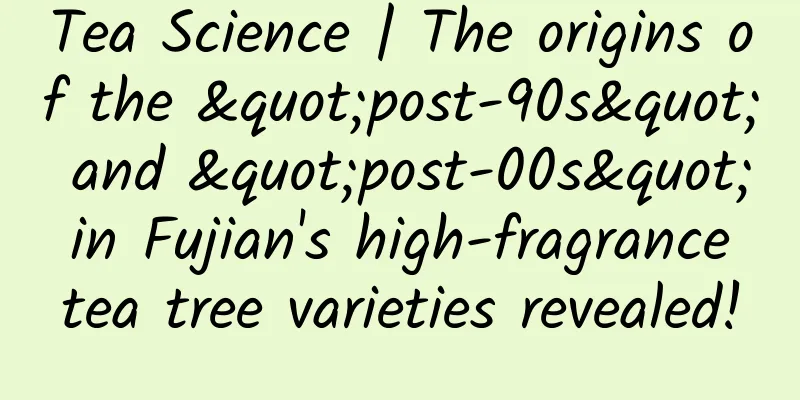Tea Science | The origins of the "post-90s" and "post-00s" in Fujian's high-fragrance tea tree varieties revealed!

|
Oolong tea is loved for its "rich aroma and rich flavor". Scholars have found that the total amount and variety of aroma substances in oolong tea are the richest among the six major types of tea. Why is oolong tea so fragrant? In addition to the sophisticated processing technology, its fresh leaf raw materials containing rich aroma substances are the basis. We call tea varieties that contain rich aroma basic substances and can produce finished tea with strong aroma high-aroma tea varieties . Aroma is one of the important indicators to measure the quality of tea. Therefore, the selection and breeding of high-aroma tea varieties has become the research focus of tea genetic breeding. Through decades of research, breeding experts from the Tea Research Institute of Fujian Academy of Agricultural Sciences have developed a series of high-aroma varieties , such as Mingke No. 1 (Golden Guanyin), Huang Guanyin, Golden Peony, Daphne, etc. The variety approval time of these high-aroma varieties was after 1990, and some were even after 2000, so they are also called the "post-90s" and "post-00s" in the tea variety world. Today, we will reveal the life stories of these “post-90s” and “post-00s”. Please see the table below first. Anxi in southern Fujian and Wuyishan in northern Fujian are the main production areas of southern Fujian Oolong and northern Fujian Oolong respectively. The local Oolong tea varieties are excellent germplasm resources. ▲ Huang Yan (Photo source: Chinese Asexual Tea Varieties) The Huangyan of Anxi, also known as Huang Jingui , has a particularly strong fragrance and is known as "the fragrance that penetrates the sky" among the people. Its high fragrance has successfully attracted the interest of breeding experts. As the backbone parent for the breeding of high-fragrance and high-quality series varieties, among the 13 excellent high-fragrance tea tree varieties shown in the table, the parents of 8 newly selected varieties are Huangyan, forming a large high-fragrance family headed by Huangyan, namely Huang Guanyin, Mingke No. 1 (Golden Guanyin), Huangqi, Daphne, Golden Peony, Yellow Rose, Purple Rose and Chungui. ▲ Tieguanyin (Photo source: Chinese Asexual Tea Varieties) Anxi Tieguanyin , with its elegant orchid fragrance and mellow taste, has also been favored by breeding experts. Among the 13 excellent high-fragrance tea tree varieties shown in the table, the parents of 6 newly selected varieties are Tieguanyin, namely Huangguanyin, Mingke No. 1 (Golden Guanyin), Chunlan, Jin Mudan, Zimeigui and Zimeigui. Among them, Huangguanyin, Mingke No. 1 (Golden Guanyin), Jin Mudan and Zimeigui are brothers and sisters with the same father and mother, all of which are bred through artificial hybridization with Tieguanyin as the female parent and Huangyan as the male parent. Dangui was bred from the natural hybrid offspring of Wuyi cinnamon, and Jiulongpao was bred from the natural hybrid offspring of Wuyi Dahongpao. Today, these highly fragrant varieties are widely planted in many tea-growing areas across the country. The black tea and oolong tea products made from their fresh leaves have rich floral and fruity aromas and each has its own characteristics. They are very popular in the market, promoting the sustainable development of the tea industry. Note ①: What is the difference between artificial hybridization and natural hybridization? ✔ Artificial hybridization refers to a hybridization method in which the female and male parents are artificially selected and the pollen of the male parent is transferred to the stigma of the female parent through artificial pollination, thereby fertilizing the female parent. ✔ Natural hybridization, also known as natural hybridization, refers to the mating of parents with different genotypes under natural conditions. Generally, only the mother is known but not the father. Note ②: Do the ID numbers of those born in the 1990s and 2000s refer to their date of birth? ✔ The "ID number" in the table refers to the number when the variety was approved. For example, Huang Guanyin "Min Shen Tea 1998002" means that this variety was approved by the Fujian Provincial Crop Variety Approval Committee in 1998 and became a provincial-level fine variety. After being promoted and planted in many places across the country, Huang Guanyin was approved by the National Crop Variety Approval Committee in 2002 and numbered "Guo Shen Tea 2002015", becoming a national-level fine variety. Note ③: Where should tea tree varieties get new “identity cards”? ✔Article 22 of the new Seed Law, which came into effect on January 1, 2016, stipulates: "The state implements a variety registration system for some non-major crops. Varieties included in the non-major crop registration catalog should be registered before promotion." On March 30, 2017, the Ministry of Agriculture issued Order No. 1 "Regulations on the Registration of Non-Major Crop Varieties" (hereinafter referred to as the "Regulations"), and tea trees were included in the first batch of 29 non-major crop variety registration catalogs. ✔The "Guidelines for Registration of Non-Major Crop Varieties Tea Tree" requires: "To apply for tea tree variety registration, the applicant shall submit a variety registration application to the provincial agricultural authority, fill in the 'Non-Major Crop Variety Registration Application Form Tea Tree', and submit relevant application documents." Article 18 of the "Measures" stipulates that "the Ministry of Agriculture shall conduct a review within 20 working days from the date of receipt of the review opinion of the provincial agricultural authority. Those that meet the requirements and submit seed samples in accordance with the regulations shall be registered and a registration certificate shall be issued." ✔By April 30, 2024, 298 tea tree varieties from 16 provinces (cities, regions) including Zhejiang have passed the registration of non-major crop varieties. Maoxie is the first tea tree variety to pass the registration, and the registration number is: GPD Tea Tree (2018) 350001. Contributor: Associate Professor Wang Fang, Department of Tea Science, Ningde Normal University Reviewers: Professor Guo Yaling from Fujian Agriculture and Forestry University, Researcher Chen Liang from the Tea Research Institute of the Chinese Academy of Agricultural Sciences References: 1. Chen Changsong, Yu Wenquan. Atlas of Tea Varieties in Fujian Province[M]. China Agricultural Science and Technology Press, 2016. 2. Chen Liang, Ma Jianqiang, Yao Mingzhe. Chinese Tea Variety Resources (Volume 1): Registered Tea Varieties. China Agricultural Science and Technology Press. 2024. |
>>: What foods don't taste salty, but are high in salt? In fact, every kitchen has them...
Recommend
It's about aging! The secret of blood aging after 70 years old is revealed
How do genetic changes that slowly accumulate in ...
How to plan a press conference for tens of thousands of people without money, people or channels?
Today we will take a look at how a press conferen...
Halfway through 2021, have internet celebrity brands collectively “collapsed”?
The excitement in the new consumer track reached ...
Security researchers discover Apple Bluetooth bug that can remotely wipe nearby iPhones/iPads
On October 14, as we all know, Apple's operat...
WeChat red envelope cover is spreading from person to person! This time it really "cracked"
During festivals, many people will distribute red...
Hong Kong iPhone 6 speculator ambushed and robbed by four gangsters
The iPhone 6 craze has not subsided yet. A couple...
Original | Google insiders teach you how to use Google Play rules to promote mobile games
According to statistics, in 2014, Google Play sha...
Baidu Cloud OS is dead, LeEco may usher in the era of ecological mobile phones
Recently, the Baidu Cloud OS R&D team, which ...
Practical traffic diversion skills for Douyin (Part 2)
Yesterday I explained to you in detail how to use...
Spending $1.7 billion and traveling hundreds of millions of kilometers just to listen to the sound of the ocean there.
Jupiter is the largest planet in the solar system...
APP Promotion Operation Manual Complete Strategy
Starting from the position of mobile Internet mar...
Real Physics Terms: From the Big Bang to Black Holes
In scientific research, every time scientists dis...
WeChat Android 7.0.17 official version released: video barrage, long press message menu new style
WeChat has just officially released version 7.0.1...
Shen Liang's internal training video tutorial on futures starting point trading system (only talk about the dry goods and no nonsense)
Chen Liang's Start-up Point Trading System Fu...
Practical examples: one article explains user growth in detail! !
The concept of User Growth (UG) originated from t...









